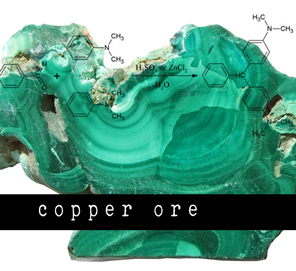

Apatite's name is derived from the Greek apate, meaning "deceit" because it is often mistaken for other minerals like aquamarine or blue tourmaline. It is the most common phosphate mineral and generally used as a source of phosphorus. Because of its brittleness, it is not often cut as a faceted gemstone but the deep blue-green colors make beautiful smaller stones. Apatite is generally untreated.
Azurite is one of two basic copper carbonate minerals (the other being malachite) and due to its softness and perfect cleavage, it is rarely found in jewelry component form. It may be assembled with malachite and stabilized with resin. It has a lovely deep blue color and was used as a source of pigment in European art from the 15th through 17th centuries.
Fluorite has the widest color range of any mineral and can be colorless, white, purple, green, blue, yellow or pink. Color variations are determined by proportions of trace elements substituting in the CaF2 structure. Banded fluorite showing purple, yellow or white is known as "Blue John" and it was first mined in Roman times in areas of England. The old Roman mines were rediscovered in the 18th century and are still in use today. Because of its easy cleavage, it is often bonded with resin for greater stability. Despite this limitation, fluorite is a good party gem: it fluoresces in ultraviolet light. How's that for a party trick?
Magnesite has similar composition to turquoise though it forms in copper poor regions so it lacks coloration from those trace elements. Naturally it is white to gray in color and it dyes well because it is porous like turquoise. Magnesite is a common mineral, and many of the beads come from deposits in China and India.
Malachite is the other principal copper carbonate and its brilliant green color is often an indicator that copper deposits are nearby. Huge deposits were found in the Ural mountains of Russia, leading to extragavant columns and furnishings throughout Russian palaces and churches. Like azurite, it has been ground and used as pigment. It's been found in Egyptian wall paintings and known to an eye paint. Today, some of the finest specimens originate from mines in the Congo.
Note: the tile of Brilliant shows dyed crazy lace agate, but the design contains rhodochrosite like in the tile of Lovelies.
Rhodochrosite is a rose-pink member of the carbonate group and a relatively new addition to gemstone jewelry, being introduced to the market around 1940. It is commonly found in hydrothermal veins near silver and copper. Transparent crystals are rare, and most samples are found in aggregrate form with alternating bands of dark and light. It is found in Argentina and the famous Sweet Home Mine in Colorado; in fact, the prevalence of rare large red crystals lead to the stone being named state mineral in 2002.
We have a long history with turquoise! Turquoise beads have been found with early Mesopotamians and extracted from mines on the Sinai Peninsula for Egyptians. It is esteemed like jade in Iran, and the turquoise found in Iran tends to be harder and a more uniform blue color than North American turquoise. In North America, Pueblo Indians used turquoise for jewelry and decoration, creating fantastic mosaics. Mexican metalsmiths introduced silver-working to the Navajo in the mid 1800s and stunning jewelry has resulted since. Even the name has become synonymous with the color itself. Southwestern turquoise is generally known by the name of the mine and varies in color and degree of matrix. In Arizona, the Sleeping Beauty mine long produced lovely uniform deep blue turquoise. Since the closure of turquoise mining in 2012, the prices commanded for Sleeping Beauty turquoise have steeply risen. Though turquoise is soft and porous, it polishes beautifully. It is often stabilized with resin to help prevent breakage, and this is a common well-accepted treatment as long as it is disclosed.
Variscite is a lesser known member of the phosphate group and often mistaken for turquoise. Like turquoise, it is porous and primarily forms in veins, nodules or crusts. It tends to be more green in color than turquoise and contains more aluminum. The most highly prized samples come from Utah and Nevada for their deep emerald color and black spider webbing.